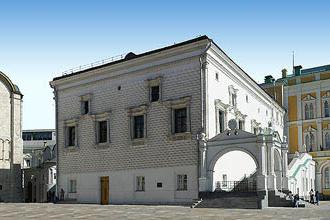In the center of the Kremlin, among the temples of Cathedral Square, there is the oldest stone building of civilian use, the Faceted Chamber, in Moscow (not including the cellar of the Courtyard Courtyard). Until the 15th century, Muscovy was mainly built of wood, but in 1462 the Grand Duke Ivan III proclaimed himself “sovereign of all Russia” and began to build new palace buildings - of stone. The first such building was the Faceted Chamber in the Kremlin. Chambers in those days called the premises intended for feasts and receptions.

Marco Ruffo, a military architect from Milan, was invited to Moscow. The architect was engaged in the replacement of wooden palace buildings with stone ones. In Russia, Ruffo was quickly dubbed Mark Fryazin from the words "jar, mud" - "foreigner." The creative fate of the architect was tragic. Most of the buildings he built were not preserved, almost all the projects initiated by Mark were subsequently transferred to another architect. The Faceted Chamber was no exception.
Fryazin began construction in 1487, thought over the entire spatial and architectural composition, worked on a masterpiece for three years, but was suspended from work for unknown reasons . Completed the construction of the chamber in 1491, another Italian - Pietro Antonio Solari, whose name the Muscovites also soon changed to Peter Fryazina.
Solari arrived in Moscow later than his compatriot, but enjoyed the king’s love and, according to some, was officially considered the main architect of the city. The Faceted Chamber owes its name to the Italian. In the decoration of the eastern facade, the architect applied the “diamond rust” characteristic of Italian architecture of that time. Large stones were used in the masonry with the front part hewn in the form of tetrahedral pyramids. The “faceted” stones are separated by flat paths, creating a mysterious play of light and shadow.
The building was erected on the very spot where once stood the mansions of Ivan Kalita and the palace of Dmitry Donskoy. It has two floors that are not connected to each other. Today you can get into the throne room from the chambers of the Grand Kremlin Palace, during the time of Ivan III the main staircases and the so-called Red Porch led to the chambers. In the 30s of the last century, the porch was destroyed, but in the 90s of the twentieth century, modern stone carvers carefully restored it from archival documents.
The faceted chamber changed its appearance several times, but its mission as the main representative hall remained the same. Here they crowned the kingdom of the Russian monarchs, received diplomats from Denmark, Germany, Hungary, Persia and Turkey, awarded the distinguished commanders with silver.
All the most important events in the life of the country: the capture of Kazan by Ivan the Terrible, the Poltava victory of the troops of Peter I, the engagement of Boris Godunov’s daughter, were celebrated by magnificent 5-6 hour dinners in the Faceted Chamber. The Boyar Duma and the Zemsky Sobors met here , making historical decisions.
The throne room has long remained the largest hall in Russia and has always been distinguished by luxury. The dilapidated original frescoes in the 17th century were restored, then whitened and covered with velvet. Today, the room looks like a mirrored multi-colored casket: the walls are covered with paintings of the Palekh masters of the Belousovs (XIX century), on the floor - a shiny parquet made of 16 species of valuable wood - the result of a large-scale restoration project that ended in 2012.
The architectural monument is part of the residence of the President of the Russian Federation. It is used only in extremely important cases for solemn meetings and state receptions. In 2012, the Kremlin’s Faceted Chamber opened its doors for tourists for the first time in its 500-year history.